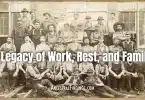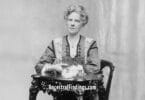Few things capture the feeling of summer, like a stop at Dairy Queen. Whether it’s a soft-serve cone after a ballgame or a burger on the way home from church, DQ has been stitched into the fabric of American family life for generations. But like so many beloved things from the mid-20th century, the Dairy Queen we grew up with has changed—and one of the clearest signs of that change is a sign itself.
If you’ve ever passed through Grafton, West Virginia, you might’ve seen her—perched on the roof of the local Dairy Queen. A girl in a white parka, mittens on, holding up a soft-serve cone like a beacon. Her nickname? The Eskimo Girl. And she’s the last of her kind, still right where she started in 1957.
Her story—and the story of Dairy Queen itself—isn’t just a slice of brand history. It’s about small towns, family traditions, design, and how even the quietest fixtures can become part of our lives in ways we don’t always notice—until they’re gone.
A Cold Idea on a Hot Day
The story of Dairy Queen begins in 1938 with John Fremont “Grandpa” McCullough and his son Alex, who developed a new kind of soft-serve ice cream in Illinois. They tested it at a friend’s shop, and when 1,600 customers lined up in two hours, they knew they were onto something special.
By 1940, the first official Dairy Queen opened in Joliet, Illinois. The concept was simple: affordable, tasty treats served up fast for families. It was a perfect match for the rising car culture of postwar America. By 1950, there were over 1,400 locations across the country.
Early DQs were usually walk-up stands. Menus and designs varied by region, and owners often gave their stores a personal touch to reflect their communities.
That’s where the Eskimo Girl came in.

The Birth of a Sign
Around the mid-1950s, a new type of sign began appearing at some Dairy Queen locations—a cheerful cartoon girl bundled for the Arctic, fur-lined hood, mittens, snow boots, and always holding a soft-serve cone. Her smile was friendly. Inviting. The kind of “cold” that still made you feel warm inside.
No one knows for sure who designed her. She likely came from a regional sign company working with local franchisees rather than the national brand. But once she appeared, she spread quickly across small towns, becoming something more than just signage.
These “Eskimo Girl” signs were built to last, made from durable porcelain enamel and often lit up at night. They showed up in places like Wilmington, Charlotte, Cleveland—and Grafton.
For the kids riding in the backseats of station wagons, she wasn’t just a logo. She was a sign of good things ahead. A landmark to look for. A silent little friend you passed on summer nights, hoping Dad would pull over for a cone.
Changing Times, Fading Signs
As the decades rolled on, things changed. In the 1970s and ‘80s, Dairy Queen went through a major redesign. Stores were modernized. Drive-thrus became standard. New logos replaced the old. And those playful rooftop signs? Most were taken down.
At the same time, the word “Eskimo,” once used casually in American marketing, came under increasing criticism. Many Arctic Indigenous peoples, including the Inuit and Yupik, consider the term outdated and offensive. In response, companies phased out imagery tied to that name.
The girl in the parka quietly disappeared. One by one, her signs were taken down, stored, or simply thrown away.
All except one.
Grafton Holds On
The Dairy Queen at 805 North Pike Street in Grafton opened in 1957, and the Eskimo Girl sign was installed that same year. Through snowstorms, heatwaves, and shifting design trends, she stayed.
Her colors faded, but she never left her post. In 2016, the owners of the store decided it was time to show her some love. She was carefully restored and, on May 28, 2016, returned to her bright, cheerful self—just as she looked in the 1950s.
When the building was rebuilt in 2019, she came down briefly—but was reinstalled once the new structure was ready.
Today, she still stands—watching over the same town that’s watched over her for more than six decades.
Inside the store, there’s a plaque shaped like a soft-serve cone that reads:
“This is the last functioning sign still operating at the same store.”
It’s not just a point of pride. It’s a marker of memory.

A Town That Remembers
Grafton is a town steeped in history. It was shaped by the Baltimore & Ohio Railroad, saw its share of Civil War conflict, and became home to one of the nation’s first cemeteries for Union soldiers.
It’s also where Mother’s Day began. In 1908, Anna Jarvis held the first official Mother’s Day observance at Andrews Methodist Episcopal Church. That church still stands—now the International Mother’s Day Shrine.
This is a town that remembers its people, its stories, its small but meaningful places.
And that includes the girl on the roof.
A Personal Memory
I remember traveling to Grafton with my high school band. Our director was from the area, and we’d go there each summer to march in the July Fourth parades. It was hot. We were exhausted. And after the last note, some of us would head straight to the Dairy Queen.
We’d grab burgers or cones, sit on the picnic tables, and there she was—smiling down at us like always. We didn’t give her much thought then. She was just part of the place.
But looking back now, I realize she was something rare. Something lasting. Something that tied the present to the past.
That’s how history often works—you don’t know something matters until it’s been with you long enough to feel like home.
A Part of Our Story
For those of us who study family history, these quiet landmarks matter. They’re more than nostalgia. They’re part of the landscape of everyday life—the backdrop to first jobs, weekend outings, long car rides, and family traditions.
Maybe your parents had their first date at a DQ. Maybe your grandparents took you there for a treat after church. Maybe you and your cousins walked there one July afternoon, quarters in your pockets, hoping they still had chocolate dip.
If you ever find yourself near Taylor County, West Virginia, take the time to stop in Grafton. Get a swirl cone. Sit on the bench. Look up.
She’s still there—right where she’s always been.






